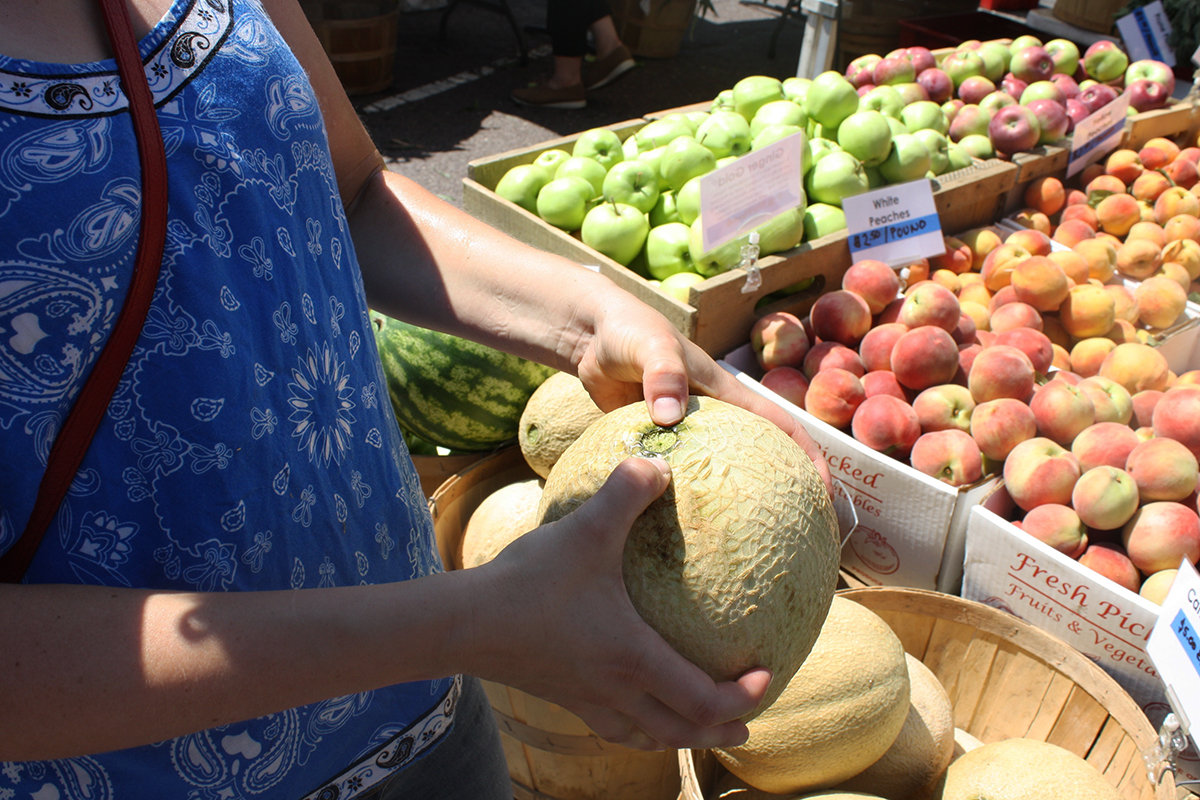How to Shop a Farmers’ Market Like a Pro

A bountiful farmers’ market haul/Photo by Jamie Ducharme
Last time I went to a farmers’ market, I panicked. Surrounded by sumptuous heaps of blackberries, peaches, and leafy greens far as the eye could see, I purchased exactly one ear of corn, one solitary green pepper, and $7 of heirloom tomatoes—most of which rotted before I could use them. Standing in my kitchen forlornly holding a bag of rotten fruit, I decided I needed help. And who better to guide a novice like me than Sarah Gupton, operations manager at Mass Farmers Markets?
I tasked Gupton with helping me procure the best assortment of fresh produce $20 can buy, while dispensing some insider tips along the way. She didn’t disappoint. Here, the results of our afternoon at the Davis Square market—on the Wednesday of National Farmers’ Market Week, no less.

Gupton selects some beets/Photo by Jamie Ducharme
After taking a lap around the market, Gupton guides me to Langwater Farm and makes a beeline for the beets ($3.50). “You can use the root, stalk, and greens,” she explains, immediately rattling off her recipe for beet pasta. (Sauté the beet stalks with garlic; roast the beets; toss the stalks, beets, and tops into pasta; add some lemon and salt; done.) A bunch of carrots ($3.50) also passes the multi-use test, as the greens can be combined with garlic, pumpkin seeds, olive oil, and pecorino to make pesto. “Everything into pesto,” Gupton laughs.
As we select our bundles, Gupton tells me that smaller is usually better—that is, more flavorful—when it comes to fresh produce. We find some small-but-not-too-small beets and carrots, and then we’re on our way.
Total cost: $7
As we move on, Gupton spies apples at a nearby stall. Just because they’re at a farmers’ market, she tells me, doesn’t mean they’re at peak growing season. Best to wait until fall, when they’ll be better and cheaper. And with that, we’re off.

Finding a ripe melon is an art/photo by Jamie Ducharme
Gupton says she likes Kimball, probably the most expansive stall at the market, because it’s an IPM farm, meaning it uses sprays and pesticides sparingly. Buying organic isn’t always necessary, but she recommends looking for products that are “conscientiously grown.”
At Kimball, Gupton lingers over a beautiful salad mix including nasturtium flowers, but eventually settles on a massive bunch of Tuscan kale, which she says is a better bang for our buck. The most tempting farmers’ market wares aren’t always the best buys, Gupton cautions. Heirloom tomatoes, for example, aren’t worth the splurge unless they’ll be the star of a dish. (Now you tell me.)
Back to the kale ($3). Gupton says it’s perfect for her favorite kale slaw, which, conveniently, also takes beets and carrots. She grabs two ears of corn (50 cents each), peeling back each husk to check for ripe kernels, and a jalapeño pepper (25 cents) to round out the dish. A cucumber ($1) also finds its way into our bag, just because it looks too good to resist.
Next we migrate to the fruits. After teaching me how to pick a ripe watermelon (check the scuffed portion of the rind that sits on the ground; you want it to have plenty of color) and cantaloupe (the area around the stem should have some give, and throw off a slightly perfume-y scent) we head to the berries. Dark colored berries are riper, Gupton says, so we select a little carton of deep red raspberries ($4). It’s expensive, but worth it. “I think of it as a treat,” Gupton says. “I don’t buy them out of season.”
Total cost: $9.25
With $3.75 left in my pocket, Gupton says it’s time to expand my horizons. Flats Mentor specializes in Asian greens, many of which I’ve never used before. Intrigued, I settle on a bunch of amaranth greens ($3). Gupton encourages me to ask the farmer how best to use them, and I learn that they’re great in soups and stir-fries.
Talking to market vendors can help you in many ways, not least of which by forming relationships with the people who grow your food. Farmers can teach you how to use unusual ingredients, like amaranth, or suggest new uses for old standbys. (Did you know corn cobs contain a “milk” that’s great in corn chowder?) Plus, farmers may be able to offer ugly or unwanted produce at discount rates. Gupton says many farmers will give away carrot, beet, radish, and turnip tops for free, or sell “seconds”—tomatoes not cosmetically fit for regular sale, but perfect for sauces and canning—at dirt-cheap prices. It’s always smart to ask, she says.
Total cost: $3
When Gupton and I finally part ways, I’m 75 cents under budget and my puny tote bag is overflowing with greens of every hue and sort. All I know: It sure beats a handful of rotten tomatoes.


